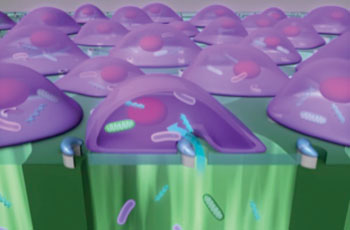Laser-Based Tool Injects Nanoparticles and Macromolecules into Cells with Minimal Damage
By LabMedica International staff writers
Posted on 30 Apr 2015
Cell biologists have developed a laser-based tool that is capable of injecting large objects such as nanoparticles, bacteria, or macromolecules into cells at a speed much greater than allowed by current technologies.Posted on 30 Apr 2015
Investigators at the University of California, Los Angeles (USA) call the new tool "biophotonic laser-assisted surgery tool (BLAST)." BLAST is, in essence, a silicon chip with an array of micrometer-wide holes, each surrounded by an asymmetric, semicircular coating of titanium.

Image: BLAST drives nanoparticles, enzymes, antibodies, and bacteria into cells at the rate of 100,000 cells per minute—significantly faster than current technology (Photo courtesy of UCLA - University of California, Los Angeles).
A reservoir of liquid that includes the particles to be delivered is located beneath the holes. Target cells are loaded onto the silicon chip, and a laser pulse is used to heat the titanium coating, which instantly boils the water layer adjacent to parts of the cell. This generates an array of microcavitation bubbles that form pores in adjacent cell membranes through which cargo is gently driven by pressurized flow.
The investigators reported in the April 6, 2015, online edition of the journal Nature Methods that the platform delivered large items including bacteria, enzymes, antibodies, and nanoparticles into diverse cell types with high efficiency—up to 100,000 cells per minute—and cell viability.
“The new information learned from these types of studies could assist in identifying pathogen targets for drug development, or provide fundamental insight on how the pathogen–host interaction enables a productive infection or effective cellular response to occur,” said contributing author Dr. Michael Teitell, professor of pediatric and developmental pathology at the University of California, Los Angeles.
Related Links:
University of California, Los Angeles













